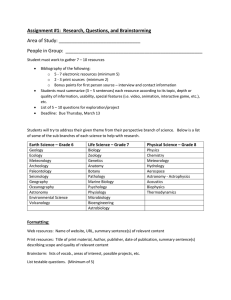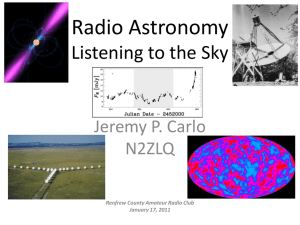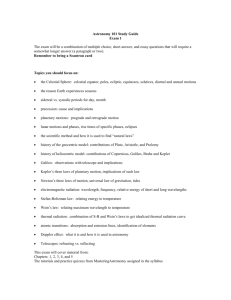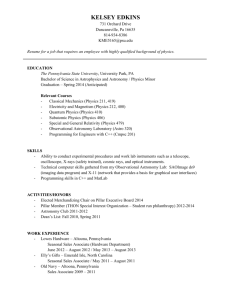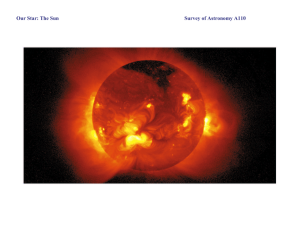Recruiting - University of Kansas Cosmology Group
advertisement
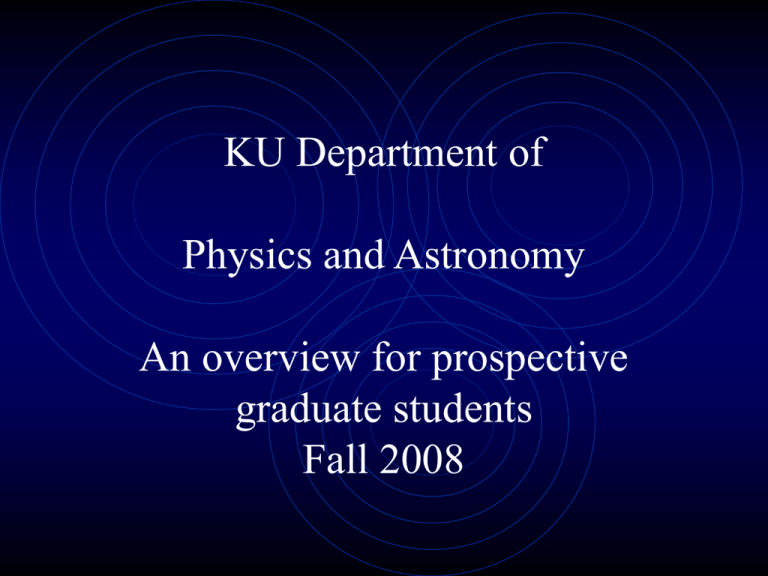
KU Department of Physics and Astronomy An overview for prospective graduate students Fall 2008 KU Physics and Astronomy by the numbers… 101 Undergraduate Physics or Astronomy Majors 44 Masters and Ph.D. Students 6 Postdoctoral research associates 26 Full-time Faculty 13 Support Personnel (machinists, secretaries, etc.) How much do they make? Starting Salaries University faculty usually have postdocs before taking that position. College faculty starting salaries are often similar to those of University postdocs. Postdocs usually last 2-3 years. Research programs – University of Kansas Department of Physics and Astronomy Fall 2008 Research programs: KU Department of Physics and Astronomy • observational astronomy • astrobiophysics • cosmology • space and plasma physics • experimental nuclear physics • experimental particle physics • theoretical particle physics •biophysics • non-linear dynamics • experimental condensed matter physics Cosmology at KU Galaxy Shapes Cutting edge Research Large Scale Structure: Cover of Nature Cosmic Microwave Background Radiation Ph.Ds in the last decade include research fellows, four college/university faculty members and a supercomputer consultant. Cluster Alignment Velocities in the Universe Molecular Biophysics Dr. Fischer Protein-DNA Interactions Molecular Motors Dr. Antonik Single-Molecular Spectroscopy Conformational Dynamics distant galaxies Astronomy at KU Active Galactic Nuclei Using telescopes on the ground and in space Galaxy clusters Star clusters Nebulae SPACE PHYSICS at KU Research is conducted for NASA and NSF on the upper atmospheres of the planets and how solar radiation and particles interact with the planetary environments. Size of each image is 60 Earth radii. This journal cover shows some our group’s predictions of x-ray intensities of the Earth’s extended hydrogen atmosphere. High-Energy, Plasma & Lab Astrophysics M.V. Medvedev’s group A star can violently explode to produce a very intense burst of radiation -- a Gamma-Ray Burst (GRB) -- that outshines all the stars altogether in the Universe for a fraction of a second. Such an explosion is even stronger than famous Supernova explosions (below) An exploding star can produce a Black Hole or a Neutron Star – the objects with huge gravity. How space-time continuum around them looks like? What happens to objects and gas near a Black Hole Horizon? Can we find Black Holes using telescopes? Does the Einstein’s General Relativity theory is valid? What observations can tell us about space and time ? These are the questions we are trying to answer. To study what the GRBs and Supernovae are and how they shine, we make theoretical models and computer simulations of relevant plasma physical processes (a realistic computer simulation result is shown below) Amazingly, these astrophysical objects can be reproduced in lab experiments with present-day high-intensity lasers, which power exceeds way the whole-world electric power production !!! Nuclear physics @ the Large Hadron Collider We collide lead ions on lead ions at the highest energies in the world to understand the fabric of the vacuum. KU is responsible for the Zero Degree Calorimeter that detects photons and neutrons produced in the collisions. Nano-devices Barrier modulation BO BO Au Au T l H g Nanowire junctions Si Switching magnetometer Qubit Thin Film Quantum computing Si Si Si Flux bias e Si Making the Highest-Tc (135K) Superconductor via atomic surgery Schrodinger’s Cat alive Ultrafast Lasers dead semiconductors KU Condensed Matter Physics Program (3 profs, 3 postdocs, 11 grads, 5 undergrads) Quantum Devices & Circuits —Siyuan Han Thin Film & Nanoscience—Judy Wu Lasers & Semiconductors—Hui Zhao spintronics Astrobiophysics Faculty: Melott & Medvedev, plus others in various KU departments. Emphasis: astrophysical ionizing radiation effects upon the Earth’s biosphere; mass extinctions; cycles in biodiversity over 100+ million-year timescales. Above: Image from a NASA press release about KU research results Collaboration: Combining research in highenergy astrophysics, paleontology, atmospheric science, geophysics, radiation biology, and more. Results: Publications in a wide variety of scientific journals, student and faculty research awards, international news coverage, research symposia, National Geographic TV special Theoretical Physics Ali Danny John Azar Mihailo Doug Farida Nefer Rainer Enrico 14 Theory Group Experimental Particle Physics at KU PROJECTS: CLEO, CMS, D0, ILC,RICE, AURA, Detector R&D, QUARKED!TM, QuarkNet PROFESSORS: Baringer,Bean, Besson, Wilson For more information: http://www.physics.ku.edu/ There are links for graduate application, information on teaching assistantships,research, etc. Self Graduate Fellowship: http://www2.ku.edu/~selfpro/ “Doctoral Fellowships for Tomorrow’s Leaders”


